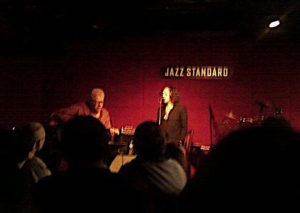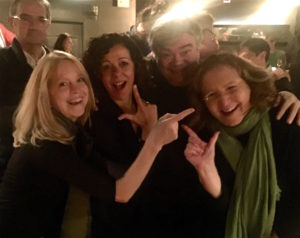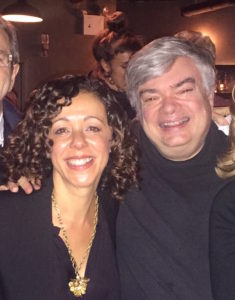 Luciana Souza and I go back a long time. The first posting on this blog was about her. We’d met a year before that, in the summer of 2002. A friend told me that she’d heard a Brazilian singer living in New York in whose music she thought I’d be interested, and she gave me a copy of Lu’s latest album, Brazilian Duos. Back then I was writing profiles of jazz musicians for the Sunday New York Times, and so was constantly on the lookout for new faces and new sounds. To that end, I listened to the first track on Brazilian Duos, “Baiao Medley—Romance.” Then I stopped the CD player and sent an e-mail to my editor at the Times. “I just heard somebody I really want to write about,” I told him. A couple of months later, I did so.
Luciana Souza and I go back a long time. The first posting on this blog was about her. We’d met a year before that, in the summer of 2002. A friend told me that she’d heard a Brazilian singer living in New York in whose music she thought I’d be interested, and she gave me a copy of Lu’s latest album, Brazilian Duos. Back then I was writing profiles of jazz musicians for the Sunday New York Times, and so was constantly on the lookout for new faces and new sounds. To that end, I listened to the first track on Brazilian Duos, “Baiao Medley—Romance.” Then I stopped the CD player and sent an e-mail to my editor at the Times. “I just heard somebody I really want to write about,” I told him. A couple of months later, I did so.
I didn’t include “She’s Brazilian, Tempered by a Bit of Everything Else” in the Teachout Reader because it was too short, and it’s never been reprinted. (I’ve posted it below.) Brief as it was, though, I think the piece managed to capture something of Lu’s personal quality, and it definitely made a difference in her life. Like my 1995 Wall Street Journal profile of Diana Krall, my piece about Lu was one of the very first English-language articles to be written about her outside the music press, and she would later tell a friend that on the morning it was published, people started noticing her on the streets of the Upper West Side.
 Listening to Brazilian Duos heightened my interest in Brazilian jazz and popular music, which I already loved but about which I as yet knew comparatively little. A year after I profiled Lu for the Times, I reviewed her next album, North and South, for the Washington Post. The first sentence of that review aptly sums up the change that my growing knowledge of the music of Brazil had wrought in me:
Listening to Brazilian Duos heightened my interest in Brazilian jazz and popular music, which I already loved but about which I as yet knew comparatively little. A year after I profiled Lu for the Times, I reviewed her next album, North and South, for the Washington Post. The first sentence of that review aptly sums up the change that my growing knowledge of the music of Brazil had wrought in me:
If the Great God of Art told me I could listen to only one kind of popular music for the rest of my life, and that it couldn’t be jazz, I’d take a deep breath—a very deep breath—and say, “Okay, make it Brazilian.”
As sometimes happens when I write a piece about an artist whose work I admire, Lu and I got to know one another after my profile was published. She asked me to write the liner notes for an album, Neruda, whose songs she was writing when we met and whose recording sessions I attended. By the time it came out, in 2004, we were close friends.
Over and above the intrinsic pleasure of her company, I was endlessly fascinated by Lu’s profound musicality. “She’s all music,” I told a friend. “Every bit of her, from top to toe.” Once I took her to a Carnegie Hall recital by Hilary Hahn, who played a piece, Claude Debussy’s Violin Sonata, that I know extremely well (I played it myself in high school, badly) and love passionately. The piece was new to Lu, and I didn’t have to look at her to sense that she was responding no less intensely and specifically than me to its oblique, elusive harmonies. By the end of the third movement, the two of us were breathing together.
One of the reasons why I saw Lu so often was that we lived in the same neighborhood. Even though she spent a lot of time on the road, she always came back home to New York sooner or later, and we made a point of getting together each time she did. But then she fell in love, moved to Los Angeles, got married in 2006, and in due course became a mother. It’s hard enough to maintain a long-distance friendship with someone who lives on the opposite coast from you, but it’s even harder when that person is a working musician who is raising a child. So we rarely saw one another after she settled down in California, and since Mrs. T came into my life right around then, the two of them never met.
 For all these reasons, my wife and I rejoiced greatly when we heard that Lu would be playing a two-nighter at the Jazz Standard, our favorite club, backed up by Romero Lubambo, the great Brazilian guitarist who accompanied her on Brazilian Duos, and Cyro Baptista, a percussionist of infinite resource and imagination. Maria Schneider, Lu’s longtime friend and sometime collaborator, told us that she and her husband were going as well, so the four of us decided to sit together, joined by our mutual friend Lúcia Guimarães, a Brazilian journalist now resident in Manhattan who is a devoted fan and chronicler of the popular music of her native land.
For all these reasons, my wife and I rejoiced greatly when we heard that Lu would be playing a two-nighter at the Jazz Standard, our favorite club, backed up by Romero Lubambo, the great Brazilian guitarist who accompanied her on Brazilian Duos, and Cyro Baptista, a percussionist of infinite resource and imagination. Maria Schneider, Lu’s longtime friend and sometime collaborator, told us that she and her husband were going as well, so the four of us decided to sit together, joined by our mutual friend Lúcia Guimarães, a Brazilian journalist now resident in Manhattan who is a devoted fan and chronicler of the popular music of her native land.
This isn’t a review, so I’ll say only that the music of Lu and her colleagues was as iridescently colorful as a double rainbow. The first set, all of it sung in Portuguese, included several of the tunes that Lu and Romero Lubambo recorded together on Brazilian Duos and its sequels, Duos II and Duos III. One of them was “Baiao Medley,” the song that first opened my ears to her artistry fourteen years ago. For an encore, the trio did Antônio Carlos Jobim’s “Águas de Março,” a song that has deep personal meaning for me—I heard Nancy LaMott sing it when she opened at the Algonquin Oak Room for the last time—and Lu, to everyone’s surprise, sang the coda in English. I teared up, and so did Mrs. T.
 Lu came straight to our table when the set was over, and there was much hugging and laughter. A crowded nightclub is no place for quiet reminiscence, but there was no need for that. Something that I’ve noticed about jazz musicians is that they never have any trouble renewing a friendship after a long separation. Accustomed as they are to the rigors of life on the road, they simply pick up where they left off. That was what happened to us: Lu, Maria, Lúcia and I behaved as though we’d seen one another the day before, and Mrs. T fit in as easily as the missing piece of a puzzle.
Lu came straight to our table when the set was over, and there was much hugging and laughter. A crowded nightclub is no place for quiet reminiscence, but there was no need for that. Something that I’ve noticed about jazz musicians is that they never have any trouble renewing a friendship after a long separation. Accustomed as they are to the rigors of life on the road, they simply pick up where they left off. That was what happened to us: Lu, Maria, Lúcia and I behaved as though we’d seen one another the day before, and Mrs. T fit in as easily as the missing piece of a puzzle.
Two nights later, Lu, Romero, and Cyro were giving a concert in Appleton, Wisconsin, and Mrs. T and I had resumed our own everyday lives. But my head is still full of the music that we heard at the Jazz Standard, and the memories that it stirred up. Friendship, like beauty, is forever.
* * *
Jazz isn’t multicultural—it’s omnicultural. No other music has been so open to ethnic cross-pollination, and no other art form has successfully assimilated so wide a range of influences without compromising its own essential identity. Still, it’s hard not to be startled by the exuberant polystylism of Luciana Souza, the Brazilian singer who begins a weeklong engagement on Tuesday at the Jazz Standard in Manhattan. Take a look at some of the other dates on her 2002 calendar:
In January, Ms. Souza (pronounced SOH-za) took part in a performance of Danilo Pérez’s ‘”Motherland Project,” a richly elaborate suite of Pan-American jazz compositions, at Lincoln Center.
In March, she sang the flamenco-flavored mezzo-soprano part of Manuel de Falla’s ballet score ”El Amor Brujo” with Robert Spano and the Atlanta Symphony.
In April, she performed songs from her critically acclaimed new CD, “Brazilian Duos” (Sunnyside), at Joe’s Pub in Manhattan, accompanied by Romero Lubambo, the virtuoso guitarist of Trio da Paz, Brazil’s leading jazz group.
Later this month, she’ll be singing the avant-garde Argentinian composer Osvaldo Golijov’s “Pasión Según San Marcos,” an evening-long setting of the Passion of Jesus Christ according to St. Mark, at the Tanglewood and Ravinia Festivals. Then she’ll come back to Manhattan to sing the big-band compositions of the avant-garde jazz trumpeter Kenny Wheeler at Birdland.
Even Ms. Souza’s Jazz Standard gig will be out of the ordinary. On Tuesday, Wednesday and Thursday, she will be singing Brazilian songs with Mr. Lubambo. On Friday and Saturday, she’ll be leading a jazz quintet, with which she will perform, among other things, selections from her second CD, “The Poems of Elizabeth Bishop and Other Songs” (Sunnyside). And yes, that’s the Elizabeth Bishop, the Pulitzer Prize-winning American poet who spent much of her life in Brazil. Ms. Souza has composed a song cycle based on Bishop’s poetry, and is now at work on a group of settings for voice and percussion (her own, naturally) of the poems of Pablo Neruda.
The common thread that runs through all these undertakings is Ms. Souza’s voice. Smooth-surfaced, coolly sensuous and dartingly agile, it is one of the most immediately identifiable sounds in jazz—even when she’s singing some other kind of music, which is fairly often. Not that she sees any reason to distinguish between the many musics she sings and loves.
“People say, ‘Oh, you’re so eclectic,’ and I usually say that I really don’t look at styles anymore,” she said in an interview last month at her Upper West Side apartment. “I recognize, well, it’s classical music or contemporary this or jazz that, or Brazilian, but I’m not worried about that. Only I don’t want to be categorized as ‘the Brazilian singer.’ I look, I sound, I am, I wouldn’t want to escape that—Portuguese is a delicious language to sing in, but I didn’t want to be just that. Let people decide for themselves what I am, and if they don’t like it, they can get their refund on the way out.”
What manner of human whirlwind is capable of such nonstop versatility? In person, Ms. Souza, 36, looks rather like a modern dancer who took up singing as a second career. She is slight and lithe, and her handsome face, serious in repose, is more often creased by a warm smile. Born in São Paulo, she came to the United States in 1985 to study jazz at the Berklee College of Music in Boston, where she later taught for several years before settling in New York. She has the charming habit of constantly apologizing for her English, even though it is fluent, fast-moving and full of the unexpected usages common to creative people who also happen to be polyglots.
“A language is something that’s alive,” she said, “and even if you make what somebody would call a mistake, something new can be born out of it. Like jazz. You can improvise.”
 Ms. Souza connects her own stylistic openness to the fact that she comes from so diverse a country. “In Brazil,” she said, “everything is so—is permissible the correct word? Anything can happen, and it’s exciting that way. I could be half-black, as I am, and go to Jewish schools for 10 years, as I did. It has to do with the nature of Brazilian colonization. You know, the Portuguese came to Brazil some 500 years ago, found the native Indians living there, and then they brought Africans from Africa for another 350 years. People really mixed—the music, the culture, the skin color.”
Ms. Souza connects her own stylistic openness to the fact that she comes from so diverse a country. “In Brazil,” she said, “everything is so—is permissible the correct word? Anything can happen, and it’s exciting that way. I could be half-black, as I am, and go to Jewish schools for 10 years, as I did. It has to do with the nature of Brazilian colonization. You know, the Portuguese came to Brazil some 500 years ago, found the native Indians living there, and then they brought Africans from Africa for another 350 years. People really mixed—the music, the culture, the skin color.”
Even so, she now thinks of herself as a full-fledged New Yorker. “Sometimes I wish I’d come sooner, but mostly I think I came at the right time for me,” she said. “It’s not competitive here, not in that bad, back-stabbing way. In Brazil, I was constantly being compared to other singers, and I didn’t fit in. Here, there are several little boxes that I fit in, and that’s great—the more, the merrier. It’s not even that I’ve proven myself. It’s that I’ve done a good amount of work, enough to know myself. I have this musical vocabulary under my arms now, and I can pull from it, I can talk within my own universe. I don’t know if I’m making any sense, but I used to be very focused on, is what I do O.K. for you and for you and for you? You ask that kind of thing as a younger person. Is what I’m doing relevant, is it valid, does it have quality, is it hip? I used to ask myself all these things, and now I’m asking less, because I know my music is all these things and none of these things, all the time.”
* * *
Luciana Souza sings her setting of Pablo Neruda’s “Sonetto 49.” This video was shot at the recording sessions for Neruda in December of 2003:
